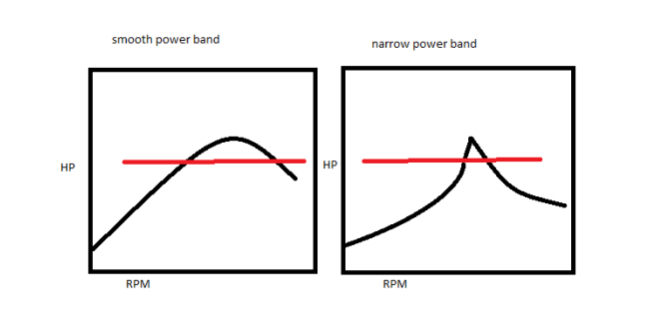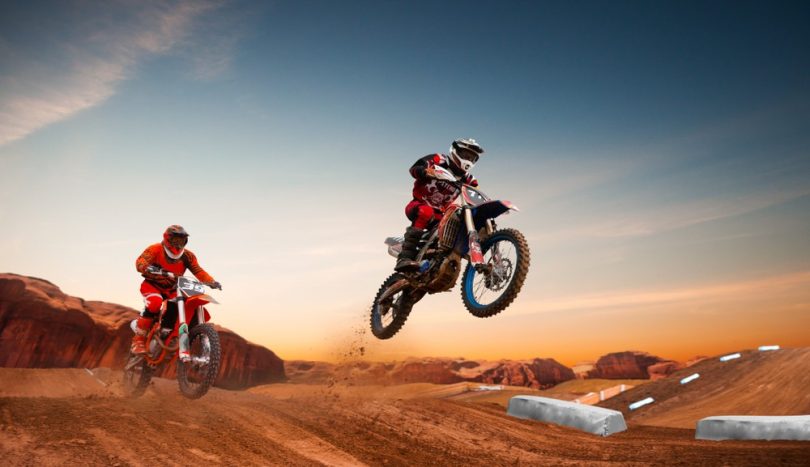Just like on any other engine, the powerband on your dirt bike refers to the RPM range where you get the maximum output from your engine. It helps the bike to accelerate faster when needed.
However, the additional speed also comes at a cost. No engine can run at its maximum efficiency all the time. Striking a balance between power and control will help your dirt bike to live longer. Join us as we explore the concept of powerband and how you can utilize it.
Dirt Bike Power Band Explained

**Photo Courtesy: WIKI Media
Contrary to what many people believe, power bans aren’t physical parts of your dirt bike’s engine. Rather, it refers to the range of RPM where your dirt bike’s engine can perform at its peak.
Your engine doesn’t provide the maximum power at its top RPM range. The powerband simply refers to the point where your engine’s peak torque meets the increasing horsepower.
However, power bands aren’t only applicable for dirt bike engines. Every engine has one, and we’ll explain how to utilize it in the later sections. They can go past 14,000 RPM in some engines, which is incredible. The powerband differs from engine to engine.
What are they used for
To be blunt, powerbands are used to reach the maximum power output of an engine. Your engine might be a hunky one, but it may not produce as much power in the top RPM range as it does in the middle range. This range where you get the maximum power output from an engine is the “power band” for that particular engine.
For those who are unfamiliar, the power of your engine is the combination of the tension (torque), multiplied by the rotational speed (RPM). If you look at a dyno graph, the region where you’ll find the most percentage of power is your powerband.

**Photo Courtesy: Quoracdn
To simplify, the point where you feel most comfortable accelerating your bike usually refers to your power bad, but what’s the use of it, right?
Here’s a simple analogy that can help you to get your head around the concept of a powerband:
From our experience, the powerband can be compared to the “effective range for acceleration” for your engine. Imagine you’re riding at 4000 RPM and want to accelerate. When you rotate the throttle, your engine will gradually gain power and the speed will increase. Now, what if you need to accelerate quicker?
Power bands come in handy in these situations. Once you provide your engine with enough power and keep the RPM within your engine’s power band, you’ll feel more comfortable and efficient in accelerating your bike, and that’s where powerbands shine.
Reasons to stay in power band
As I’ve explained above, a power band is the rev range where your engine produces its maximum torque. As a result, there is a lot of power at your disposal at any time for quick maneuvers as long as your engine stays within the powerband.
However, you don’t need your engine to be at its maximum capacity all the time. If you try to do so, your bike might accelerate like crazy, causing you to lose control easily. Powerbands are good for power production, but not for controlling.
The primary reason to stay in the powerband is to enjoy an adrenaline rush when you cruise through the terrain at high speed. This is where your engine is the most capable. If you’re racing with your dirt bike and want to overcome the one in front of you, an engine on its powerband may help you gain speed quickly.
Reasons to move away from power band
Staying on the powerband may be great for your speed and performance, but it has the potential to damage your engine in long term. Remember, this is where your engine is doing most of its work. So you might enjoy the adrenaline rush speeding up your dirt bike like crazy, but it can actually damage the inner parts of your engine if you stay in the band for too long.
Another great reason to step away from the power band is control. At the maximum output range, your bike becomes over-sensitive to drive, reducing your overall control over the bike.
Especially if you are going through traffic, moving away from the powerband will give you better control and quick maneuverability so that you can safely react to sudden changes in the environment.
Pro Tips on Maximizing Your Power Band
The power band provides your engine’s maximum efficiency. Here’s how you can maintain the power band for longer:
Assess your skill level
Powerband can change with a lot of influences like the design and quality of the engine, the size of the intake/exhaust valves, etc. Each engine’s powerband is different from the other and there is no physical way to assess the powerband. You’ll have to ride your dirt bike and figure it out yourself.
An engine can have 3 possible power bands depending on its RPM. The engines that enter the power band at a relatively low RPM are known as the low-power band. There are also mid- and high-power bands that operate in higher RPMs.
If you’re a beginner, the low-or the mid-power band will be perfect for you. Most high-class engines use high-power bands and aren’t recommended for newcomers. Once you are comfortable using low/mid-range power bands, you can step up your game as most seasoned pros use high-tier powerbands.
Maintain the engine regularly
High powerband users need to take care of their engines more frequently. A high-end powerband puts strain on your engine over time and requires extensive use of the clutch. As a result, your bike will become less and less capable over time.
High-tier powerbands make the engine less durable in the long run and you’ll have to repair or replace parts of your engine more frequently. Clutch plates, piston rings, and reeds are among the parts that need the most frequent repairs/replacements.
If you’re just starting out, you can experiment with your dirt bike all you want. However, as your skill level progresses, you’ll be more prone to maintaining a highly tuned engine.
Terrain Obstacles
Utilizing the powerband also depends on the type of terrain you’re trying to ride on. Low-tier powerbands are good at acceleration but suck at controlling, especially at tight bends. If you are a low- or mid-tier powerband user, you’ll have great success on muddy or sandy terrains that are small and tight.
On the other hand, high-end powerbands are great for wide highways and hard grounds. The control you have on your bike will depend on factors like elevation, soil composition, and how often your bike has to experience jumps. These engines perform their best on open and wide roads.
FAQs
Q. Do 4-stroke dirt bikes have powerbands?
Yes, Every single engine has its own powerband. However, most 4-stroke engines by design have a low-end powerband.
Q. Are 4 strokes faster than 2 strokes?
No. When it comes to speed and power, 2-stroke engines win as they are designed to run at a higher RPM. 4-stroke engine prevails in durability and efficiency.







